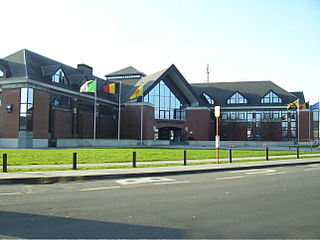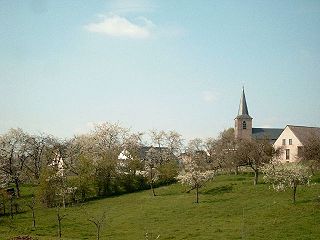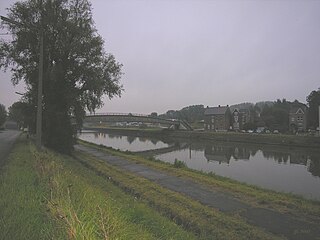This is a list of the mayors of Leuven.
| Mayor of Leuven | |
|---|---|
This is a list of the mayors of Leuven.
| Mayor of Leuven | |
|---|---|
Dyle department was created on 1 October 1795, when the Austrian Netherlands was officially annexed by the French Republic, with Leuven located on its territory. [1]
| Name | Date of birth — date of death | Term |
|---|---|---|
| Michel Thielens | 17 November 1756 — 23 March 1822 | 1794 — 1797 |
| Félix Tonnelier | 26 August 1768 — 14 December 1801 | 1797 — 1798 |
| Michel Claes | 31 December 1759 — 6 February 1818 | 1798 — 1800 |
| Joseph de Bériot | 17 July 1764 — 20 October 1819 | 1800 — 1804 |
During First French Empire, Leuven continued to be a part of Dyle department.
| Name | Date of birth — date of death | Term |
|---|---|---|
| Joseph de Bériot | 17 July 1764 — 20 October 1819 | 1804 — 1808 |
| Gérard d'Onyn de Chastre | 13 April 1757 — 27 January 1837 | 1808 — 1811 |
| Jan Baptist Plasschaert | 21 May 1769 — 19 May 1821 | 1811 — 1814 |
Dyle department was disestablished in 1815 and replaced with South Brabant (Zuid-Brabant) province. The South Brabant province was then renamed simply "The Province of Brabant" in 1830 and became the central province of Belgium. [2]

| Name | Date of birth — date of death | Term |
|---|---|---|
| Antoine-Joseph d'Elderen | 7 August 1761 — 28 December 1827 | 1814 — 1817 |
| Gérard d'Onyn de Chastre | 13 April 1757 — 27 January 1837 | 1817 — 1830 |
In 1995 Province of Brabant was split into three parts, one of which was Flemish Brabant, where Leuven is now located. [3]
| Photo | Name | Party | Date of birth — date of death | Term |
|---|---|---|---|---|
 | Jean De Néeff | Unionism | 25 February 1773 — 6 April 1833 | 1830 — 1833 |
 | Guillaume Van Bockel | 24 April 1789 — 10 March 1863 | 1833 — 1842 | |
 | Ferdinand d'Udekem | Liberal Party | 25 September 1798 — 28 March 1853 | 1842 — 1952 |
 | Charles de Luesemans | 20 April 1808 — 26 March 1882 | 1852 — 1863 | |
 | Henri Peemans | 21 February 1810 — 22 January 1880 | 1864 — 1869 | |
 | Théodore Smolders | Catholic Party | 26 July 1809 — 7 August 1899 | 1869 — 1872 |
 | Leopold Vander Kelen | Liberal Party | 6 June 1813 — 3 April 1895 | 1872 — 1895 |
 | Frederik Lints | 24 May 1833 — 26 September 1900 | 1896 — 1900 | |
 | Vital Decoster | 22 Oktober 1850 — 16 December 1904 | 1901 — 1904 | |
 | Leo Colins | 4 January 1851 — 29 January 1938 | 1905 — 1914 | |
| Alfred Nerincx (acting during WWI) | Catholic Party | 30 March 1872 — 11 October 1943 | 1914 — 1918 | |
 | Leo Colins | Liberal Party | 4 January 1851 — 29 January 1938 | 1918 — 1921 |
 | Ferdinand Smolders | Catholic Party | 18 April 1858 — 29 June 1927 | 1921 — 1927 |
| Remi Van der Vaeren | 26 February 1882 — 13 December 1956 | 1927 — 1932 | ||
| Raoul Claes | Liberal Party | 2 Oktober 1864 — 2 July 1941 | 1933 — 1938 | |
| Remi Van der Vaeren | Catholic Party | 26 February 1882 — 13 December 1956 | 1939 — 1941 | |
| Richard Bruynoghe (acting during WWII) | 4 November 1881 — 26 March 1957 | 1941 — 1944 | ||
| Remi Van der Vaeren | 26 February 1882 — 13 December 1956 | 1944 — 1947 | ||
| Alfons Smets | Christian People's Party | 25 July 1908 — 11 February 1979 | 1947 — 1952 | |
| François Tielemans | Socialist Party | 8 December 1906 — 21 December 1962 | 1952 — 1958 | |
| Alfons Smets | Christian People's Party | 25 July 1908 — 11 February 1979 | 1958 — 1976 | |
| Alfred Vansina | 9 July 1926 – 3 April 2018 | 1977 — 1994 | ||
 | Louis Tobback | SP.A | 3 May 1938 | 1 January 1995 — 31 December 2018 |
 | Mohamed Ridouani | Vooruit | 24 June 1979 | January 2019 [4] — incumbent |
Brabant is a traditional geographical region in the Low Countries of Europe. It may refer to:

Leuven, also called Louvain, is the capital and largest city of the province of Flemish Brabant in the Flemish Region of Belgium. It is located about 25 kilometres east of Brussels. The municipality itself comprises the sub-municipalities of Heverlee, Kessel-Lo, Leuven proper, Wilsele, Wijgmaal and part of Haasrode and Korbeek-Lo. It is the eighth largest city in Belgium, with more than 100,244 inhabitants.

Liedekerke is a municipality located in the Belgian province of Flemish Brabant. On January 1, 2006, Liedekerke had a total population of 11,920. It is also situated in the Pajottenland.The total area is 10.08 km2 which results in a population density of 1,183 inhabitants per km2. Liedekerke means "church on the little hill."

Waterloo is a municipality in Wallonia, located in the province of Walloon Brabant, Belgium, which in 2011 had a population of 29,706 and an area of 21.03 km2 (8.12 sq mi). Waterloo lies a short distance south of Brussels, and immediately north-east of the larger town of Braine-l'Alleud. It is the site of the Battle of Waterloo, where the resurgent Napoleon was defeated for the final time in 1815. Waterloo lies immediately south of the official language border between Flanders and Wallonia.

Wavre is a city and municipality of Wallonia, capital of the province of Walloon Brabant, Belgium.

The Dyle is a river in central Belgium, left tributary of the Rupel. It is 86 kilometres (53 mi) long. It flows through the Belgian provinces of Walloon Brabant, Flemish Brabant and Antwerp. Its source is in Houtain-le-Val, near Nivelles in Walloon Brabant.

Dyle was a department of the French First Republic and French First Empire in present-day Belgium. It was named after the river Dyle (Dijle), which flows through the department. Its territory corresponded more or less with that of the Belgian province of Brabant, now divided into Walloon Brabant, Flemish Brabant and the Brussels-Capital Region. It was created on 1 October 1795, when the Austrian Netherlands and the Prince-Bishopric of Liège were officially annexed by the French Republic. Before the annexation, its territory was partly in the Duchy of Brabant, partly in the County of Hainaut, and partly in some smaller territories.

The Hesbaye, or Haspengouw, is a traditional cultural and geophysical region in eastern Belgium. It is a loamy plateau region which forms a watershed between the Meuse and Scheldt drainage basins. It has been one of the main agricultural regions in what is now Belgium since before Roman times, and specifically named in records since the Middle Ages, when it was an important Frankish pagus or gau, called Hasbania in medieval Latin.

The Duchy of Brabant, a state of the Holy Roman Empire, was established in 1183. It developed from the Landgraviate of Brabant of 1085–1183, and formed the heart of the historic Low Countries. The Duchy comprised part of the Burgundian Netherlands from 1430 and of the Habsburg Netherlands from 1482, until it was partitioned after the Dutch revolt of 1566–1648.

The Province of Brabant was a province in Belgium from 1830 to 1995. It was created in 1815 as South Brabant, part of the United Kingdom of the Netherlands. In 1995, it was split into the Dutch-speaking Flemish Brabant, the French-speaking Walloon Brabant and the bilingual Brussels-Capital Region.

The Koningshooikt–Wavre Line, abbreviated to KW Line and often known as the Dyle Line after the Dijle (Dyle) river, was a 60 kilometres (37 mi)-long fortified line of defence prepared by the Belgian Army between Koningshooikt and Wavre which was intended to protect Brussels from a possible German invasion. Construction on the KW Line began in September 1939 after World War II had begun but while Belgium itself remained a neutral state. It was subsequently extended southwards from Wavre towards Namur. The line itself consisted of bunkers, anti-tank ditches, and barricades including so-called Cointet-elements and played a key role in Allied strategy during the German invasion of Belgium in May 1940. However, its role in the actual fighting was ultimately minimal. In 2009 an inventory of surviving emplacements was begun.

Luttre is a village of Wallonia and a district of the municipality of Pont-à-Celles, located in the province of Hainaut, Belgium, about 15 km north of Charleroi and 50 km south of Brussels along the Charleroi-Brussels Canal, railway line and motorway. Its name means crystal clear water.

At the Battle of Elixheim, 18 July 1705, also known as the Passage of the Lines of Brabant during the War of the Spanish Succession, the Anglo-Dutch forces of the Grand Alliance, under the Duke of Marlborough, successfully broke through the French Lines of Brabant. These lines were an arc of defensive fieldworks stretching in a seventy-mile arc from Antwerp to Namur. Although the Allies were unable to bring about a decisive battle, the breaking and subsequent razing of the lines would prove critical to the Allied victory at Ramillies the next year.

The Arrondissement of Nivelles is an arrondissement in Wallonia and Belgium. It is the only arrondissement in the province of Walloon Brabant, and is coterminous with it. Before 1995, it was one of three arrondissements in the Province of Brabant.

Sint-Agatha-Rode, named after the third-century Christian martyr Saint Agatha of Sicily, is a Dutch-speaking village in Belgian province of Flemish Brabant and lies within the district of the town of Huldenberg. Historically Sint-Agatha-Rode was an independent municipality (Gemeente) until the merger of Belgian municipalities in 1977 when it was joined to the town of Huldenberg.

The Old University of Leuven is the name historians give to the university, or studium generale, founded in Leuven, Brabant, in 1425. The university was closed in 1797, a week after the cession to the French Republic of the Austrian Netherlands and the principality of Liège by the Treaty of Campo Formio.

Margaret of Louvain was a servant murdered by thieves. She is venerated in the Roman Catholic Church; her shrine is in St. Peter's Church in Louvain.

F.H.G.M. (Frans) Ronnes was a Dutch politician. He was a member of the Christian Democratic Appeal. From 2001 to 2013 he was mayor of the municipality of Haaren.
The following is a timeline of the history of the municipality of Leuven, Belgium.
The pagus of Brabant was a geographical region in the early Middle Ages, located in what is now Belgium. It was the first region known to have been called Brabant, and it included the modern capital of Belgium, Brussels. It was divided between the neighbouring counties of Flanders, Hainaut and Louvain (Leuven) in the eleventh century. It was the eastern part, which went to the Counts of Louvain, which kept the name in use, becoming the primary name of their much larger lordship. This led to other regions later being named Brabant - in particular, the French and Dutch-speaking areas east of the Dyle, including Leuven and Wavre, which are still known as "Brabant"; and secondly the province of North Brabant in the Netherlands.
![]() Media related to Mayors of Leuven at Wikimedia Commons
Media related to Mayors of Leuven at Wikimedia Commons